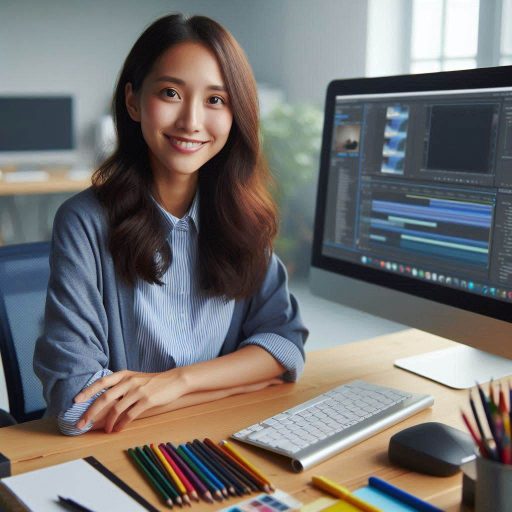Introduction
Costume design in the film industry refers to creating outfits that reflect a character’s personality and setting.
Costume designers craft clothing that helps define characters, supporting the film’s overall tone and atmosphere.
These outfits must match the character’s backstory, role, and emotional journey.
Costume design plays a vital role in storytelling.
It helps set the time period, location, and mood of the scene.
Well-designed costumes allow the audience to understand who the character is without dialogue.
A character’s attire can signal their growth, struggles, or transformation throughout the movie.
Costumes also impact how the audience perceives the characters.
Through clothing, the audience can distinguish between a hero, villain, or supporting character.
The choice of fabric, color, and style helps convey a character’s social class, profession, or emotional state.
A costume can also evoke cultural references, making the story relatable and engaging for viewers.
By shaping the visual narrative, costume design adds depth to the film.
It creates memorable characters and establishes the film’s world, whether historical, futuristic, or fantasy.
Without saying a word, costumes tell stories and enhance the film’s emotional impact.
In fact, costume design in film is essential to building characters and enhancing storytelling.
It influences the audience’s perception and immerses them in the world of the film.
Each costume reflects the character‘s arc and enriches the viewing experience.
Understanding costume design deepens the appreciation of how films visually connect with audiences.
History of Costume Design in Film
The evolution of costume design in film from the early days of cinema to modern times
Costume design has evolved significantly from the early days of cinema to modern times.
In the silent film era, costumes were simple, relying on bold colors and exaggerated styles to convey character traits.
Transform Your Career Today
Unlock a personalized career strategy that drives real results. Get tailored advice and a roadmap designed just for you.
Start NowAs cinema developed, costume design became more sophisticated, blending with storytelling to enhance character development and the film’s visual appeal.
Key milestones and influential costume designers in the industry
One key milestone was the introduction of color film in the 1930s, which revolutionized costume design.
Designers like Edith Head and Adrian set new standards for costumes by crafting iconic looks that influenced both fashion and film.
In the 1950s and 1960s, designers such as Givenchy and Orry-Kelly contributed to the glamorization of film stars, further elevating costume design as an essential part of filmmaking.
Modern costume designers, like Colleen Atwood and Ruth E. Carter, have continued this legacy.
They‘ve shaped how costumes not only complement characters but also reflect the film’s time period and setting.
These designers have won numerous awards for their ability to seamlessly integrate costumes into film narratives.
How costume design reflects the cultural and societal norms of different time periods
Costume design also mirrors the cultural and societal norms of its time.
In early Hollywood, costumes often reflected conservative values, with strict guidelines on what was appropriate.
As society evolved, so did film costumes.
The rebellious spirit of the 1960s, for example, brought more daring and expressive designs to the screen.
Today, costume design continues to reflect the complexities of modern society, addressing themes like gender, race, and identity.
The history of costume design in film is a testament to its importance in shaping characters and storytelling.
It remains a crucial part of filmmaking, blending artistry with cultural reflection.
Read: Creating a Multimedia Art and Design Studio
The Role of a Costume Designer
The responsibilities of a costume designer in the filmmaking process
A costume designer plays a crucial role in the filmmaking process.
Their primary responsibility is creating costumes that reflect the film‘s characters.
Costume designers work closely with the director to understand the movie’s vision and tone.
They research historical periods, fashion trends, and cultural symbols to design authentic outfits.
The collaboration between costume designers, directors, and actors
Collaboration is key to the costume designer‘s role.
Transform Your Career Today
Unlock a personalized career strategy that drives real results. Get tailored advice and a roadmap designed just for you.
Start NowCostume designers regularly consult with the director to ensure their designs align with the film‘s artistic direction.
They also collaborate with actors to ensure the costumes enhance the character‘s portrayal.
The actors’ comfort and ability to move freely are critical considerations.
A well-designed costume tells a story about the character before they even speak.
Costume designers carefully select colors, fabrics, and accessories to reflect a character‘s personality, background, and motivations.
For example, bold colors might represent confidence, while darker tones may suggest mystery.
Every detail is considered to support the narrative.
How costume designers create costumes that enhance the characters’ personalities and the overall visual storytelling
In addition to characters, costume designers contribute to the film‘s overall visual storytelling.
Their work helps create a cohesive aesthetic that blends with the cinematography and production design.
Whether it‘s a period drama, fantasy film, or contemporary piece, the costumes must fit within the world being built.
Ultimately, costume designers are artists who use clothing to enrich the storytelling experience.
Their creative contributions are vital to bringing the director‘s vision to life on screen.
The costumes not only define the characters but also help transport the audience into the world of the film.
Through their craft, costume designers ensure that every outfit enhances both the character and the story.
Read: Costume Design Trends for 2024
Research and Concept Development
The process of researching and developing costume concepts for a film
Costume design begins with thorough research and thoughtful concept development.
Designers study the film‘s script, its setting, and the director’s vision.
This research phase helps them understand the era, culture, and characters, providing a foundation for accurate and meaningful costume choices.
How costume designers use historical references, character analysis, and mood boards to inspire their designs
Designers use historical references to ensure costumes align with the time period or setting.
For example, in period dramas, historical accuracy is crucial.
Transform Your Career Today
Unlock a personalized career strategy that drives real results. Get tailored advice and a roadmap designed just for you.
Start NowThey analyze authentic garments, fabrics, and accessories from the era, infusing realism into their designs.
Even in fantasy or futuristic films, elements of history often inspire the design process.
Character analysis plays a key role in costume development.
Designers explore a character’s personality, background, and role in the story.
A costume must reflect who the character is and their journey throughout the film.
For instance, a hero’s transformation might be symbolized by a shift in clothing style or color scheme.
To visualize their ideas, designers create mood boards that combine images, textures, and color palettes.
These boards help communicate the costume concept to directors, actors, and the production team.
They also serve as creative guides, ensuring consistency throughout the design process.
Examples of successful costume designs that were inspired by careful research
Several successful costume designs have emerged from meticulous research.
In Mad Max: Fury Road, designer Jenny Beavan used historical and post-apocalyptic references to create unique, functional costumes.
The designs reflected the harsh, barren environment while staying true to each character‘s role in the dystopian world.
In a nutsell, researching and developing costume concepts is vital to a film‘s storytelling.
Through historical references, character analysis, and mood boards, designers bring characters to life and enhance the cinematic experience.
Read: How to Land Your First Job in Multimedia Design

Creative Process and Collaboration
The creative process behind creating costumes for a film, from sketching to final fittings
Costume design in film requires a blend of creativity and collaboration.
The process begins with sketching.
Designers translate ideas into sketches that reflect the characters‘ personalities.
After approvals, they select fabrics and colors to match the film’s tone.
Next, the costume team constructs the outfits, ensuring they align with the director‘s vision.
Transform Your Career Today
Unlock a personalized career strategy that drives real results. Get tailored advice and a roadmap designed just for you.
Start NowFinal fittings allow for adjustments, ensuring the costumes perfectly fit the actors and the story.
The importance of collaboration between costume designers, directors, and other creative team members
Collaboration between costume designers and the creative team is crucial.
Designers work with directors to match costumes with the film‘s aesthetic and mood.
They also consult with set designers and lighting experts to ensure the costumes complement the overall visual experience.
These conversations help the designer balance practical elements like movement and durability with artistic vision.
How costume designers work closely with actors to ensure that costumes fit the characters’ personalities and the narrative of the film
Costume designers must also collaborate closely with actors.
They ensure the costumes fit the characters’ personalities and align with the actor‘s interpretation.
Designers discuss how the clothing helps the actors embody their roles, and adjustments are made to improve comfort and movement.
This partnership ensures the costumes not only look right but feel authentic to the character.
The costume design process is a delicate mix of creativity and teamwork.
Each stage, from sketching to final fittings, shapes the narrative through clothing.
The collaboration between the costume designer, director, and actor helps bring the character and story to life on screen.
Effective teamwork makes costume design an integral part of the filmmaking process.
Read: Collaborating in Multimedia Art Projects
Technical Aspects of Costume Design
The technical aspects of costume design, such as fabric choice, color palettes, and costume construction
Costume design involves a meticulous balance of artistry and technicality.
One critical aspect is the choice of fabric.
Designers select fabrics that align with a character‘s personality, setting, and historical context.
Silk, wool, and cotton all evoke different moods, adding depth to each costume.
In addition to fabric choice, color palettes play a pivotal role in costume design.
Colors symbolize emotions, define character traits, and create visual harmony.
Transform Your Career Today
Unlock a personalized career strategy that drives real results. Get tailored advice and a roadmap designed just for you.
Start NowA designer carefully selects each hue to tell a story within the scene.
How costume designers consider practicality, movement, and authenticity when creating costumes for specific characters or scenes
Costume construction is another crucial technical element.
Designers must ensure costumes fit properly and allow for movement.
Comfort and durability are essential, especially for action-packed scenes.
Stiff fabrics may look impressive but could restrict an actor‘s movement, disrupting the performance.
Designers also prioritize authenticity.
Historical accuracy in costumes immerses the audience in the film‘s time period, making the narrative more believable.
Practicality is a key concern for designers.
They ensure costumes not only look visually striking but also withstand multiple takes and long shooting days.
Designers consider how costumes will interact with lighting and special effects.
For instance, certain fabrics react differently under bright lights, altering their appearance on camera.
Examples of how technical details can enhance the overall visual impact of a film
These technical details dramatically enhance a film‘s visual impact.
For example, the intricate embroidery in “The Great Gatsby” heightened the opulence of the Roaring Twenties. Similarly, the futuristic designs in “Blade Runner” contributed to the dystopian atmosphere.
Through careful attention to fabric, color, and construction, costume designers elevate storytelling to a new level.
Their expertise ensures that costumes seamlessly support the film‘s vision while adding layers of meaning.
Find Out More: Day in the Life of a Professional Art Director
Budgeting and Resource Management
The challenges of working within a budget constraints in costume design for film
Working within budget constraints presents significant challenges in costume design for film.
Designers must create visually compelling costumes while adhering to financial limitations.
This balance often requires prioritizing certain elements, like key character outfits, over less prominent costumes.
Negotiating these choices while still delivering high-quality work is a delicate process.
Transform Your Career Today
Unlock a personalized career strategy that drives real results. Get tailored advice and a roadmap designed just for you.
Start NowHow costume designers manage resources, such as sourcing materials, renting or creating costumes, and overseeing costume departments
Costume designers also manage resources meticulously.
Sourcing materials, whether renting or purchasing, demands careful planning and cost comparisons.
Some costumes may need to be created from scratch, which involves coordinating with tailors and other experts.
Designers must also oversee costume departments, ensuring the efficient use of both human and material resources to stay on schedule and within budget.
Tips on how costume designers can be resourceful and creative while staying within budget limitations
Resourcefulness and creativity play a crucial role in overcoming budget challenges.
Costume designers can repurpose materials or modify existing garments to fit a character‘s aesthetic.
They also rely on collaboration, seeking input from the production team to make informed financial decisions.
Maintaining good relationships with fabric suppliers or rental companies can result in discounts or better deals, saving costs.
To stay within budget, designers should keep detailed expense logs and regularly review financials with the production team.
Prioritizing essential pieces and opting for cost-effective alternatives without sacrificing quality can make a significant difference.
Planning ahead, knowing where to splurge, and where to save helps designers stretch every dollar while maintaining the director‘s vision.
Essentially, costume designers must balance creativity and resourcefulness with strict budget management.
By planning carefully, sourcing materials wisely, and finding innovative solutions, designers can meet financial demands without compromising the film‘s visual storytelling.
Conclusion‘
Costume design in film plays a crucial role in enhancing the storytelling and character development.
It is an art form that requires attention to detail, creativity, and a deep understanding of the story being told.‘
Costume design in film involves creating unique and distinctive looks for characters that help to bring them to life on screen.
The costumes not only reflect the time period and setting of the film but also provide insights into the personality and motivations of the characters.‘
Costume designers work closely with directors, actors, and production teams to ensure that the costumes align with the overall vision of the film.
They pay attention to color palettes, fabrics, accessories, and even minor details that may not be immediately noticeable but contribute to the overall aesthetic of the film.‘
By appreciating the artistry and creativity behind costume design in film, viewers can gain a deeper understanding and appreciation for the storytelling process.
Transform Your Career Today
Unlock a personalized career strategy that drives real results. Get tailored advice and a roadmap designed just for you.
Start NowEvery costume choice is deliberate and serves a purpose in advancing the narrative and developing the characters.‘
Therefore, next time you watch a film, take a moment to admire the costumes and consider the thought and effort that went into creating them.
Costume design is an essential part of the filmmaking process and deserves to be recognized for its impact on the storytelling experience.




